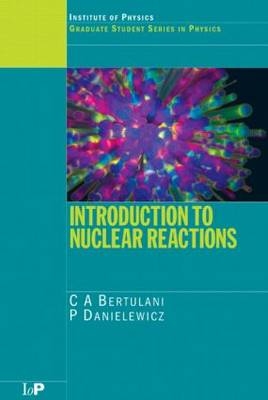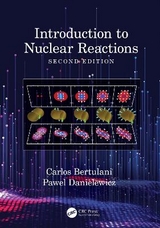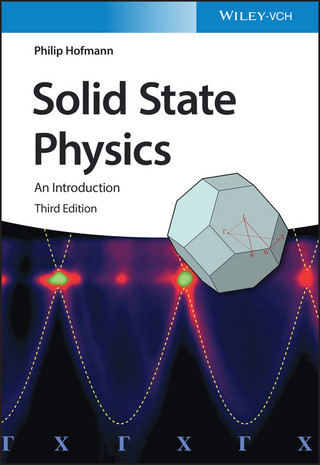
Introduction to Nuclear Reactions
Institute of Physics Publishing (Verlag)
978-0-7503-0932-5 (ISBN)
- Titel erscheint in neuer Auflage
- Artikel merken
Until the publication of Introduction to Nuclear Reactions, an introductory reference on nonrelativistic nuclear reactions had been unavailable. Providing a concise overview of nuclear reactions, this reference discusses the main formalisms, ranging from basic laws to the final formulae used to calculate measurable quantities.
Well known in their fields, the authors begin with a discussion of scattering theory followed by a study of its applications to specific nuclear reactions. Early chapters give a framework of scattering theory that can be easily understood by the novice. These chapters also serve as an introduction to the underlying physical ideas. The largest section of the book comprises the physical models that have been developed to account for the various aspects of nuclear reaction phenomena. The final chapters survey applications of the eikonal wavefunction to nuclear reactions as well as examine the important branch of nuclear transport equations.
By combining a thorough theoretical approach with applications to recent experimental data, Introduction to Nuclear Reactions helps you understand the results of experimental measurements rather than describe how they are made. A clear treatment of the topics and coherent organization make this information understandable to students and professionals with a solid foundation in physics as well as to those with a more general science and technology background.
PREFACE
CLASSICAL AND QUANTUM SCATTERING
Experiments with Nuclear Particles
Theories and Experiments
Reactions Channels
Conservation Laws
Kinematics of Nuclear Reactions
Cross Sections, Center of Mass and Laboratory Frames
Classical Scattering
The Classical Cross Section
Example: Rutherford scattering
Orbiting, rainbow and glory scattering
Stationary scattering of a plane wave
Appendix 1.A - Systems of units
Appendix 1.B - Useful constants and conversion factors
Exercises
References
THE PARTIAL-WAVE EXPANSION METHOD
The Scattering Wave Function
Radial Equation
Free Particle in Spherical Coordinates
Phase Shifts
Scattering Amplitude and Cross Sections
Integral Formulae for the Phase-Shifts
Hard Sphere Scattering
Resonances
Scattering from a Square-Well
Low Energy Scattering: Scattering Length
Scattering Length for Nucleon-Nucleon Scattering
The Effective Range Formula
Effective Range for Nucleon-Nucleon Scattering
Coulomb Scattering
An Illustration: a - a Scattering
Appendix 2.A - Absolute Phase Shifts and Levinson Theorem
Exercises
References
FORMAL SCATTERING THEORY
Introduction: Green's Functions
Free Particle's Green's Functions
Scattering Amplitude
Born Approximation
Transition and Scattering Matrices
The Two-Potential Formula
Distorted Wave Born Approximation
Partial-Wave Expansion of the S-Matrix
Partial-Wave Free Particle's Green's Functions
Collision of Particles with Spin
Collisions of Identical Particles
Scattering of Clusters of Identical Fermions
Imaginary Potentials: Absorption Cross Section
Appendix 3.A - Analytical Properties of the S-Matrix
Exercises
References
COMPOUND NUCLEUS REACTIONS
Introduction
The Nucleon-Nucleon Interaction
The Nucleus as a Strongly Absorbing Medium
Mean Free Path of a Nucleon in Nuclei
Fermi Gas Model
Formal Theory of the Optical Potential
Empirical Optical Potential
Compound Nucleus Formation
R-Matrix
Average of the Cross Sections
Level Densities in Nuclei
Compound Nucleus Decay: The Weisskopf-Ewing Theory
Reciprocity Theorem
The Hauser-Feshbach Theory
Appendix 4.A - The Shell Model
Exercises
References
FUSION AND FISSION
Introduction
The Liquid Drop Model
General Considerations on Fusion Reactions
The One Dimensional WKB Approximation
Connection Formulas in WKB
The Three-Dimensional WKB Approximation
Heavy Ion Fusion Reactions
Sub-Barrier Fusion
Superheavy Elements
Occurrence of Fission
Mass Distribution of the Fragments
Neutrons Emitted in Fission
Cross Sections for Fission
Energy Distribution in Fission
Isomeric Fission
The Nuclear Reactor
Appendix 5.A - The Nilsson Model
Exercises
References
DIRECT REACTIONS
Introduction
Level Width and Fermi's Golden Rule
Direct Reactions: A Simple Approach
Direct Reactions: Detailed Calculations
Applications of the Shell Model
Direct Reactions as Probe of the Shell Model
Nuclear Vibrations
Photonuclear Reactions - Giant Resonances
Coulomb Excitation
Electromagnetic Transition Probabilities for Nuclear Vibrations
Nuclear Excitation in the Deformed Potential Model
Appendix 6.A - Multipole Moments and the Electromagnetic
Interaction
Exercises
References
NUCLEAR REACTIONS IN THE COSMOS
Cosmic Rays
Stellar Evolution: Hydrogen and CNO Cycles
White Dwarfs and Neutron Stars
Synthesis of Heavier Elements
Supernovae Explosions
Thermonuclear Cross Sections and Reaction Rates
Reaction Networks
Models for Astrophysical Nuclear Cross Sections
Slow and Rapid Capture Processes
Tests of the Solar Models
Indirect Methods for Nuclear Astrophysics Reactions
Exercises
References
HIGH ENGERGY COLLISIONS
Introduction
Nucleons as Billiard Balls
Applications of the Classical Model
The Eikonal Wavefunction
Elastic Scattering
Coulomb Amplitude and Coulomb Eikonal Phase
Total Reaction Cross Sections
Scattering of Particles with Spin
The Optical Limit of Glauber Theory
Pauli Blocking of Nucleon-Nucleon Scattering
Glauber Theory of Multiple Scattering
Coulomb Excitation
Inelastic Scattering
Charge-Exchange Reactions
Exercises
References
RELAVISTIC COLLISIONS
Unpacking the Nucleus
The Boltzmann-Uehling-Uhlenbeck Equation
Wigner Function
Numerical Treatment of Transport Equations
Structure of Hadrons
Quantum Chromodynamics
The Quark-Gluon Plasma
Exercises
References
| Erscheint lt. Verlag | 1.5.2004 |
|---|---|
| Verlagsort | London |
| Sprache | englisch |
| Maße | 156 x 234 mm |
| Gewicht | 885 g |
| Themenwelt | Naturwissenschaften ► Physik / Astronomie ► Atom- / Kern- / Molekularphysik |
| ISBN-10 | 0-7503-0932-6 / 0750309326 |
| ISBN-13 | 978-0-7503-0932-5 / 9780750309325 |
| Zustand | Neuware |
| Haben Sie eine Frage zum Produkt? |
aus dem Bereich



